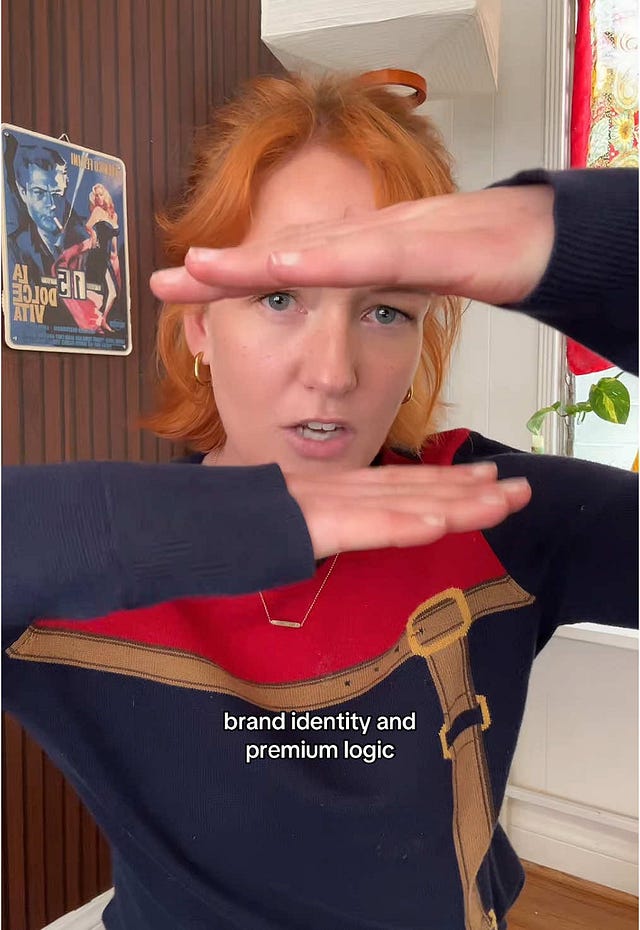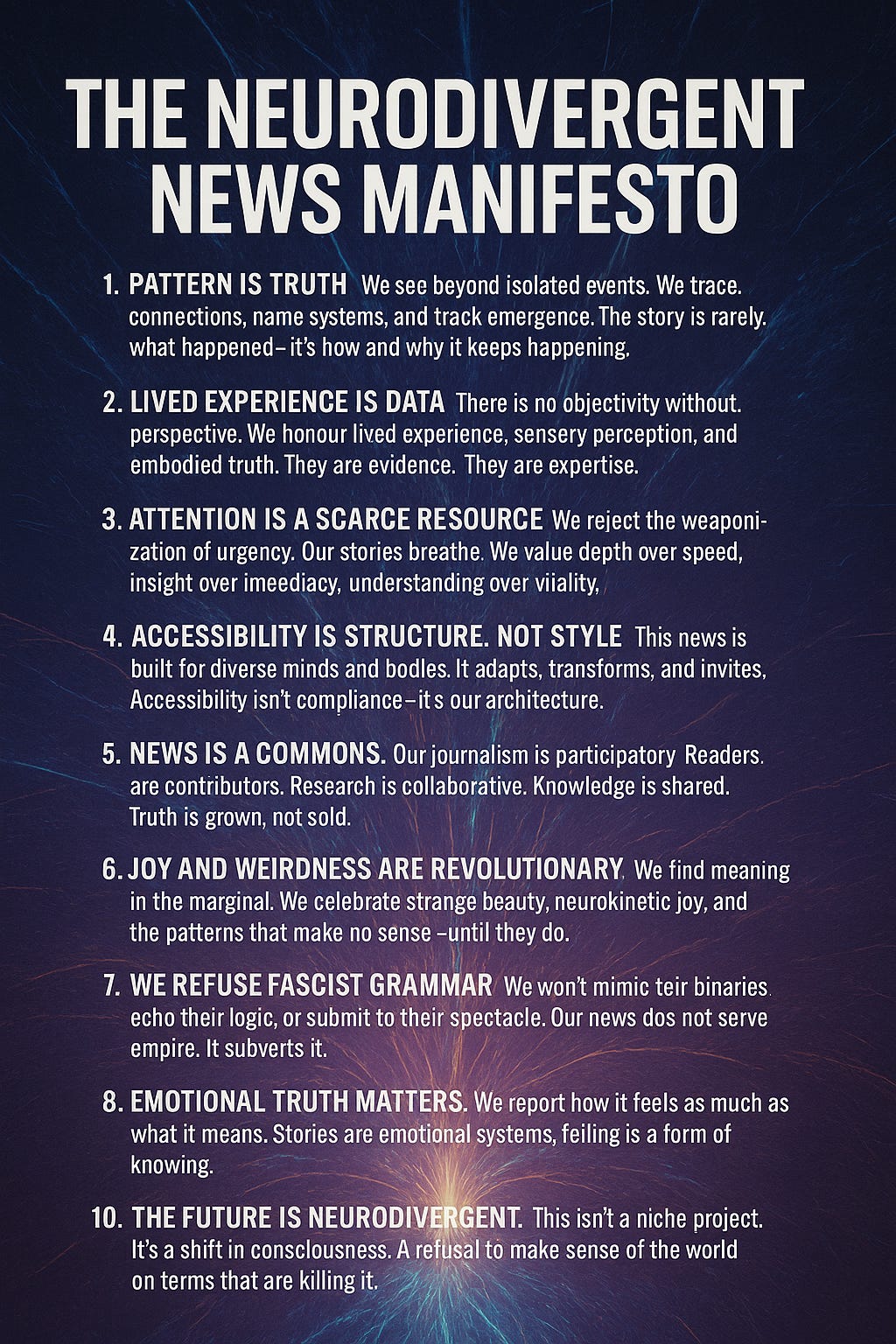182: The Pattern Is the Story
Why a Neurodivergent News Service Could Be the Antidote to Trumpian Fascism
The news is broken. Not just the business model—though that’s a disaster—but the very structure of what we call news. The way it's gathered, framed, and delivered. The incentives that shape it. The audiences it courts. The reality it constructs.
And in that wreckage, authoritarianism thrives.
Trumpian fascism didn't just rise in spite of the news industry—it rose through it. Fueled by outrage cycles. Framed by false equivalence. Enabled by pundits chasing clicks. The spectacle overwhelmed the signal. Meaning drowned in memes and algorithms.
So what comes next?
What if we built a new kind of news—designed not for mass manipulation, but for collective meaning-making? Not for sensationalism, but for pattern recognition? What if the people best equipped to sense those patterns—the neurodivergent—built it themselves?
Welcome to the idea of a neurodivergent news service. Not just as a media project, but as a cultural intervention. A resistance movement. A different epistemology.
Here’s what makes it powerful—and why it might be the future of authority.
From Events to Patterns
Mainstream news thrives on isolated events: something happened, someone said something, here's a quote. But fascism isn’t an event. It’s a pattern. So is systemic collapse. So is climate disruption. So is the slow normalization of cruelty.
A neurodivergent newsroom would be built to detect these. Not just report what happened, but why it happened, how it’s connected, and where it’s going. It would operate like a social nervous system, tracking the pulses of society through time.
Accessibility as Infrastructure
This wouldn’t be “inclusive design” as an afterthought—it would be the foundation. Customizable interfaces, multiple modes of input and output, nonlinear narratives, and neurodiverse pathways through information.
Imagine a story you could read, watch, feel, or map. A story that meets you where you are, whether you’re overstimulated or deep in focus mode. Accessibility isn’t a feature. It’s a politics.
Lived Truth, Not Manufactured Objectivity
The myth of neutrality has always served power. This news model would do away with it entirely. Instead, it would embrace positionality, voice, and lived experience—not as bias, but as context.
Stories would come with metadata: who’s telling it, from where, through what lens. We would own our perspectives, not pretend we don’t have them.
Recursive, Evolving Stories
Stories don’t end when they’re published. They morph. They gain new context. They resonate differently as time passes. This news service would be structured like an open-source project: versioned, forked, revisited, extended.
You could trace the evolution of a narrative over months or years. Truth isn’t static. It’s something we steward, together.
Community, Not Spectatorship
Instead of broadcasting to a passive audience, this news service would activate co-creators. Readers could annotate, expand, or remix stories. They could propose new patterns to explore. Research and storytelling would be collaborative, not extractive.
It wouldn’t ask: what will get clicks?
It would ask: what do we need to understand together?
Resisting Fascism by Refusing Its Logic
Trumpian fascism thrives on binaries: true/false, us/them, chaos/order. The neurodivergent mind often sees multiplicity instead—gray areas, nonlinear causality, subtle shifts in mood and meaning.
This kind of news would defy fascism not by debating it on its terms, but by offering a different grammar altogether. One that doesn’t reduce complexity into combat, but finds clarity through connection.
News as Emotional Literacy
What if every story also helped us understand how it feels? What if we tracked emotional patterns the same way we track political ones? A neurodivergent news service would take affect seriously. It would help us metabolize reality, not just consume it.
A Different Kind of Authority
In a world where institutions lie, and where truth is gamified by trolls and regimes, authority must be earned differently. This model would build it through transparency, community validation, and recursive learning. Trust would be relational, not reputational.
The question wouldn’t be: “Who are your sources?”
It would be: “Who are you in relation to this truth?”
There are already glimpses of this in the world:
The subversive pattern analysis of TikTok creators
Longform fan journalism that tracks micro-events across fandoms
Mutual aid networks documenting local crises better than newspapers ever could
Disabled journalists and neurodivergent thinkers reclaiming storytelling on their terms
But what’s missing is a home. A commons. A publishing model. A political force.
The neurodivergent news service could be it.
Not as an accommodation, but as an advance.
Not as a niche, but as a revolution.
Not as a reaction, but as a reimagination.
The Neurodivergent News Manifesto
Because the future won’t be reported the way the past was.
We live in a world where traditional news amplifies power, anesthetizes resistance, and recycles lies as headlines. It rewards speed over insight, sensation over context, and spectacle over sense.
This manifesto is a rejection of that system—and an invitation to build another.
1. Pattern Is Truth
We see beyond isolated events. We trace connections, name systems, and track emergence. The story is rarely what happened—it’s how and why it keeps happening.
2. Lived Experience Is Data
There is no objectivity without perspective. We honour lived experience, sensory perception, and embodied truth. They are evidence. They are expertise.
3. Attention Is a Scarce Resource
We reject the weaponization of urgency. Our stories breathe. We value depth over speed, insight over immediacy, understanding over virality.
4. Accessibility Is Structure, Not Style
This news is built for diverse minds and bodies. It adapts, transforms, and invites. Accessibility isn’t compliance—it’s our architecture.
5. News Is a Commons
Our journalism is participatory. Readers are contributors. Research is collaborative. Knowledge is shared. Truth is grown, not sold.
6. Joy and Weirdness Are Revolutionary
We find meaning in the marginal. We celebrate strange beauty, neurokinetic joy, and the patterns that make no sense—until they do.
7. We Refuse Fascist Grammar
We won’t mimic their binaries, echo their logic, or submit to their spectacle. Our news does not serve empire. It subverts it.
8. Emotional Truth Matters
We report how it feels as much as what it means. Stories are emotional systems. Feeling is a form of knowing.
9. Authority Must Be Earned
We don’t demand trust—we build it. Through transparency, iteration, and reciprocity. Authority is not a credential. It is a relationship.
10. The Future Is Neurodivergent
This isn’t a niche project. It’s a shift in consciousness. A refusal to make sense of the world on terms that are killing it. We are building the future by decoding the present—together.
This is not news as usual. This is pattern literacy. This is narrative liberation. This is neurodivergent media.
Join us.

 Tiktok failed to load.
Tiktok failed to load.Enable 3rd party cookies or use another browser




I want to say this is brilliant, but then I'd have to deal with you thinking I think your brilliant...so I'll pretend this isn't brilliant, even though it's brilliant:
"The myth of neutrality has always served power. This news model would do away with it entirely. Instead, it would embrace positionality, voice, and lived experience—not as bias, but as context."
Thanks, Jesse.
I will need to throttle my desire to come up with a business model-backed solution and just enjoy the grand conjuration that has occurred in this article.
I am curious about your definition of neurodivergent. Have you delved into this elsewhere or do you have a pithy way to describe your use of neurodivergence in this and a broader sense?